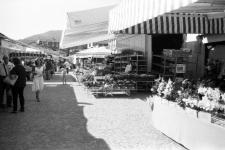|
Au Printemps Chambre Folding |
Manufactured or assembled in France from (Circa) 1910 to (After) 1910.
Inventory number: 3278
See the complete technical specifications
Chronology of cameras Au Printemps
What is referred to as "Chambre Folding" on page 3 of the 1910 Au Printemps store catalog is a common folding plate camera. It comes in two sizes: 9 x 12 cm and 13 x 18 cm.
It is made of waxed walnut with a leather bellows. The carriage movement is controlled by a double rack and pinion mechanism. The lens board can move vertically and laterally. The camera is sold without a lens or shutter.
Even if you were to come across this model one day, you would likely have difficulty identifying it precisely. Only a potential plate magazine, screwed onto the wood, might provide some guidance.
The manufacturer is unknown.

The "Printemps" department store was created on May 11, 1865, at the same time as the modernization and transformation of Paris under the Second Empire. The store was established in a still undeveloped area, but with great potential for growth: the Chaussée-d'Antin neighborhood. This location also benefited from its proximity to Saint-Lazare train station. Thus, the "Printemps" settled at the corner of Rue du Havre and Boulevard Haussmann in a building designed by the architect Jules Sédille. The inauguration took place on November 3, 1865. In 1874, four buildings were added to the first one.
The "Printemps" innovation lies in principles that are intended to instill confidence in its clientele. The store practices fixed prices, and bargaining is no longer acceptable. The aim is to sell innovative and quality products at affordable prices. At the end of the season, faded fabrics are put on sale at reduced prices, known as sales. In January 1866, Jules Jaluzot had the idea of turning this still poorly assumed practice into a large seasonal operation.
The "Printemps" store's early years saw it shine throughout France and then abroad. The 1867 and 1878 Universal Exhibitions contributed to this recognition. In full expansion, the department store was becoming increasingly cramped in its walls: it needed a building that matched its new success. On March 9, 1881, a fire devastated a large part of the building. The inauguration of the new "Printemps" took place in March 1883. The construction of the store's new buildings gave rise to a specific architecture that was entrusted to Paul Sédille, who created a commercial monument. To achieve this, he used very ingenious new processes, using glass and iron. Inside the store, you can discover a central nave as well as galleries connected by a central bridge accessible by a grand staircase.
In 1883, the "Printemps" was the first public place to be fully equipped with an electric lighting system. At the mezzanine level, the customer can admire the "electric factory" behind a glass wall.
In 1900, the sumptuous Art Nouveau pavilion of the "Printemps" was located in the heart of the Universal Exhibition. The interior was inspired by the theme of the violet, the favorite flower of the "Printemps." At the beginning of the century, a new mode of transportation, the metro, served the capital and facilitated access to the "Printemps" stores.
A second store was inaugurated in April 1910, on the even-numbered side of Boulevard Haussmann. It is dominated by a dome that illuminates a large hall 42 meters high, and also includes a central staircase with four Art Nouveau-inspired revolutions. In 1909, a new slogan appeared in advertising catalogs: "Les magasins du Printemps sont les plus élégants de Paris".

During the First World War, the "Printemps" displayed its own mannequins in the storefront, thus differentiating its image from other department stores that used series mannequins. On September 28, 1921, a fire broke out in the new store. Inside, only a few structures remained intact. The reconstruction work was carried out by Georges Wybo, who extended the store to Rue Charras.
(Source Wikipedia)
Interesting links or bibliography :
Add a link or element of bibliography, a picture taken with this camera, a picture of box or an ads about this camera
Your photos taken with the same camera:
Cameras from Ebay France (Au Printemps) (Uploaded each 3 hours)








